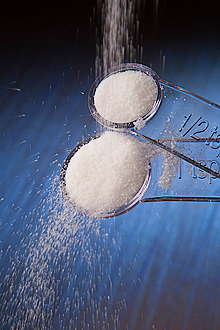High Salt Detected by Sour and Bitter Taste Cells
High Salt Detected by Sour and Bitter Taste Cells
Researchers discovered that high levels of salt trigger both sour- and bitter-sensing taste cells in mice. The finding may help explain why we find high levels of salt unappetizing.
Photo by Peggy Greb, courtesy of USDA.
Over the past 15 years, the laboratories of Dr. Nicholas Ryba of NIH’s National Institute of Dental and Craniofacial Research (NIDCR) and Dr. Charles Zuker from Columbia University Medical Center have identified cells in the tongue that detect sweet, sour, bitter, umami (savory) and low-salt tastes. Sweet and umami tastes are normally considered appetizing, while sour and bitter tastes are unpleasant.
Salt taste is unique because most animals will consume it up to a certain level, but after that it becomes unappealing. Sodium in dietary salt (sodium chloride) is an essential ion used in every cell of the body. However, excess salt can be harmful. Taste receptor cells expressing the epithelial sodium channel (ENaC) detect low levels of sodium salts, but the cells behind aversion to higher salt levels were unknown.
In their new study, the researchers set out to determine how high salt levels are sensed. Led by Dr. Yuki Oka in Zuker’s lab, they first searched for inhibitors of high salt responses in mice. They reported online in Nature on February 13, 2013, that one compound partially blocked responses to high levels of salt without affecting the response to low levels. The compound also inhibited responses to bitter stimuli. Additional examination of individual taste receptor cells confirmed that high concentrations of salt activated bitter-sensing taste cells.
Further experiments showed that mice genetically engineered to lack bitter taste had reduced taste responses to high levels of salt. However, they still rejected concentrated salt solutions. Since sour taste is also unappealing to mice, the researchers tested whether sour-sensing cells might likewise contribute to high-salt detection. When sour-tasting cells were deactivated, the scientists found, the mice’s ability to taste high salt was also partially reduced, but again the mice avoided strongly salty stimuli.
When both bitter and sour tastes were blocked, mice no longer showed an aversion to salt. They readily consumed sodium chloride even at concentrations as high as those in seawater.
These findings suggest that while specialized salt receptor cells may have evolved to make salt appealing, activation of sour- and bitter-tasting cells by high salt concentrations helps prevent the intake of salt levels that could severely impact health.
“Over the years our studies have shown that each taste quality—sweet, bitter, sour, umami and low-salt—is mediated by different cells,” Ryba says. “So we thought there must be different taste receptor cells for high salt. But quite unexpectedly, Dr. Yuki Oka found high salt is mediated by cells we already knew.”
Future studies will be needed to validate the roles of these salt-sensing cells in humans. This research may ultimately lead to strategies that curb our desire for high-salt diets and help us avoid too much sodium.
By Miranda Hanson, Ph.D.
###
* The above story is reprinted from materials provided by National Institutes of Health (NIH)
** The National Institutes of Health (NIH) , a part of the U.S. Department of Health and Human Services, is the nation’s medical research agency—making important discoveries that improve health and save lives. The National Institutes of Health is made up of 27 different components called Institutes and Centers. Each has its own specific research agenda. All but three of these components receive their funding directly from Congress, and administrate their own budgets.





















